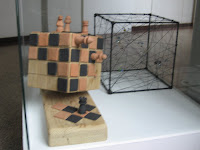 Budapest is a city full of many different museums, one of which is the Iparművészeti Múzeum, or the Museum of Applied Arts, which several students visited today on our free afternoon. (The museum is readily recognizable by its green tiled roof and dome as seen in the picture.)
Budapest is a city full of many different museums, one of which is the Iparművészeti Múzeum, or the Museum of Applied Arts, which several students visited today on our free afternoon. (The museum is readily recognizable by its green tiled roof and dome as seen in the picture.)
The Budapest museum was the third applied arts museum created in Europe, only after the ones in London and Vienna.
 It boasts a large collection of artistic furniture, glassware, metalwork, and the second largest collection of Ottoman Turkish rugs! But perhaps the most interesting exhibit in the museum, especially for math students, was the collection of puzzle blocks and games, including the Rubik’s Cube and many other variations on a similar theme. The exhibit even included a giant block puzzle colored to resemble a watermelon that visitors could rearrange and play with!
It boasts a large collection of artistic furniture, glassware, metalwork, and the second largest collection of Ottoman Turkish rugs! But perhaps the most interesting exhibit in the museum, especially for math students, was the collection of puzzle blocks and games, including the Rubik’s Cube and many other variations on a similar theme. The exhibit even included a giant block puzzle colored to resemble a watermelon that visitors could rearrange and play with!
Already in this blog, we have been introduced to famous mathematicians Paul Erdős and Alfréd Rényi. It is worthwhile to introduce you to a few more famous Hungarians, both connected with the Applied Arts’ puzzle exhibit. The first is Ernő Rubik, the inventor of the Rubik’s Cube, which was prominently showcased in the exhibit. Rubik was born in Budapest and became a designer, architect and university professor. The first prototype of the Rubik’s cube was created in 1974, and first marked under the name of “magic cube” in 1975.
 It was not until 1980 that the toy was renamed “Rubik’s Cube” after its inventor. Rubik can be seen with his invention in the picture to the left. This year, 2010, the Rubik’s Cube will celebrate its 30th anniversary! (For more information on the Rubik’s Cube check out www.rubiks.com)
It was not until 1980 that the toy was renamed “Rubik’s Cube” after its inventor. Rubik can be seen with his invention in the picture to the left. This year, 2010, the Rubik’s Cube will celebrate its 30th anniversary! (For more information on the Rubik’s Cube check out www.rubiks.com)
Another important Hungarian
 connected with the Iparművészeti Múzeum exhibit is Tibor Szentivanyi. All of the colorful brainteaser puzzles on display came from his collection. Szentivanyi was also born in Budapest and studied computer technology at the Budapest University of Technology. He became a well-known computer engineer but it is said his real passion was puzzles and games. He became both an inventor and collector of puzzle games. After the invention of the Rubik’s Cube, Szentivanyi played a key role in marketing the toy worldwide. He even organized the first ever Rubik’s Cube World Championship in 1982, right here in Budapest!
connected with the Iparművészeti Múzeum exhibit is Tibor Szentivanyi. All of the colorful brainteaser puzzles on display came from his collection. Szentivanyi was also born in Budapest and studied computer technology at the Budapest University of Technology. He became a well-known computer engineer but it is said his real passion was puzzles and games. He became both an inventor and collector of puzzle games. After the invention of the Rubik’s Cube, Szentivanyi played a key role in marketing the toy worldwide. He even organized the first ever Rubik’s Cube World Championship in 1982, right here in Budapest!
These two influential Hungarians represent another reason why we are studying here in Budapest... not only are we here because of Budapest's strong mathematics history but also we are here for the fun and new experiences! Just as Rubik's Cubes are both mathy and fun - our trip has been full of math, new experiences, and fun!
 Several students participated in a Professor's Dinner tonight at an upscale restaurant called Apostolok. After extensive work on renovations of the restaurant that opened in 1902, the Apostolok reopened a couple years ago and still attracts guests with traditional Hungarian dishes. The group of
Several students participated in a Professor's Dinner tonight at an upscale restaurant called Apostolok. After extensive work on renovations of the restaurant that opened in 1902, the Apostolok reopened a couple years ago and still attracts guests with traditional Hungarian dishes. The group of  students started out with a cold starter that included the infamous Hungarian goose liver. They then went on to eat main entrees which include plates of tenderloin steak, lamb, salmon, and chicken paprika. The group then headed to a dessert cafe, where they indulged themselves in a plethora of traditional Hungarian sweets.
students started out with a cold starter that included the infamous Hungarian goose liver. They then went on to eat main entrees which include plates of tenderloin steak, lamb, salmon, and chicken paprika. The group then headed to a dessert cafe, where they indulged themselves in a plethora of traditional Hungarian sweets.
Ah, one of my favorite restaurants in Budapest! What a great museum find!
ReplyDeleteThe museum sounds fascinating and fun (who wouldn't like puzzles everywhere?), and the food sounds amazing!
ReplyDeleteNothing about the Rubik Cube or other mathematicals puzzles is currently displayed at the museum.
ReplyDeleteHi,
ReplyDeleteFeeling good to found this awesome blog. I must said that you are the genious one who give good with unique knowledge to us. There are lots of Cubing Stores, where you can buy carious kind of Cubes. But I can give you one another shop which one is also best in my experience. Thanks...